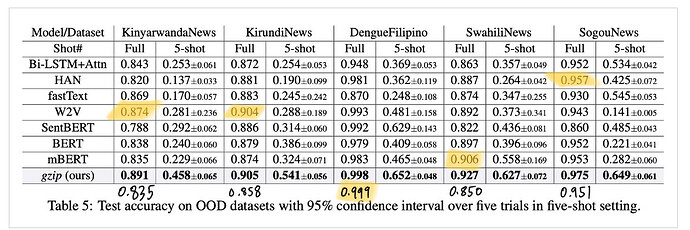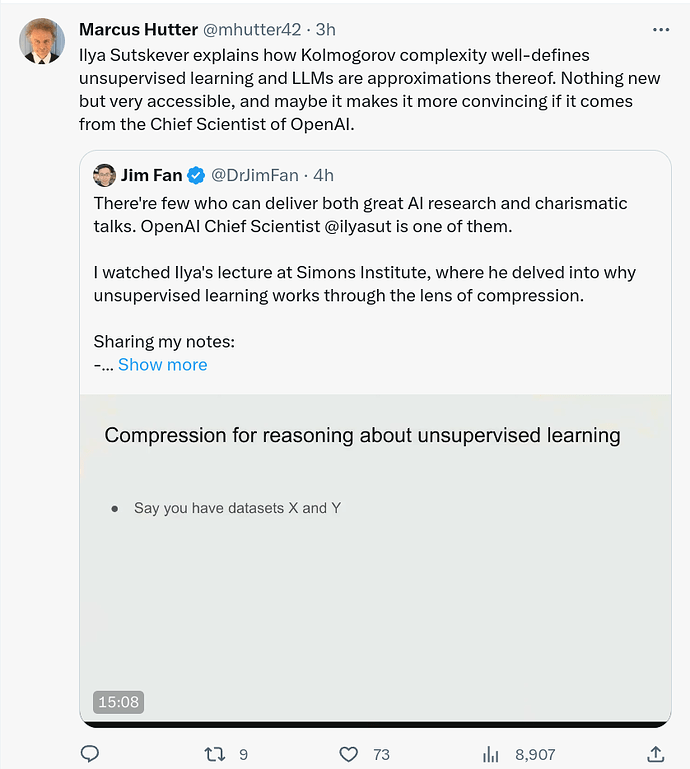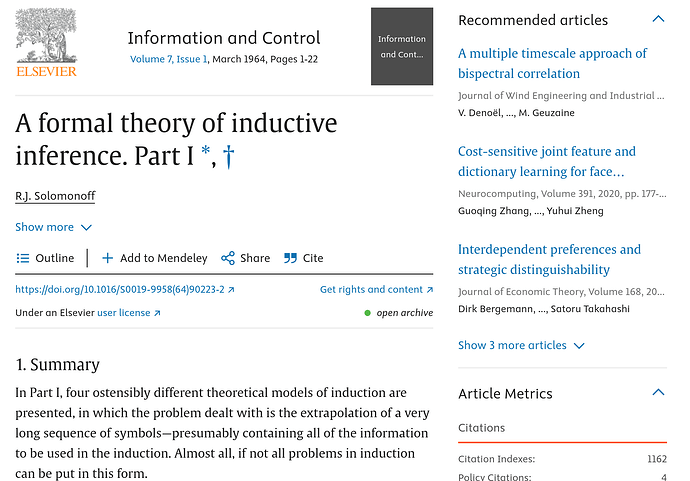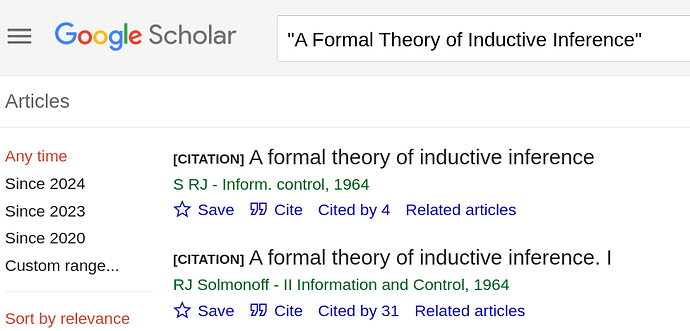Ya know… It’s incredibly ironic how people are scrambling to apply LLMs to improve ML resulting in profound societal transformations including AGI but already GPT4 is more intelligent on the key issue of allocation of capital in ML and no one in the position to allocate capital is paying any attention to what it says (below). I suppose the main (and it is major) criticism of what it says is an omission: It doesn’t emphasize how often people are mislead into thinking that lossless compression based on full Turing complete codes produces models that are no better than Bayesian Information Criterion (as Oxford was when I approached them about a prize at the start of the pandemic) – the codes for which can’t be used to construct programs:
Q: In a contest to produce the best model of the data in evidence where contestants are highly motivated by monetary prize awards, what are some reasons for using the size of its executable archive as the best loss function?
A: In a context of a competitive model-building where a monetary prize is involved, using the size of the executable archive as the loss function provides several compelling advantages:
-
Universality & Fairness: This approach makes no assumptions about the data or the models being used. Thus, it is universally applicable, irrespective of the specifics of the problem or the techniques the participants choose to use.
-
Avoiding Overfitting: This strategy discourages overfitting. Overfit models may memorize the training data without learning its underlying structure, meaning they won’t generalize well to new data. Using the size of a compressed file to express the data’s complexity encourages models to learn and represent the essential structure of the data without overfitting.
-
Encouraging Innovation: Since this loss function is not standard in many machine learning contexts, it encourages participants to think creatively and innovatively about how to best structure and compress the information present in their models.
-
Practical Relevance: Finally, in real-world applications, creating compact representations of data is often highly desirable. Models that can compress data efficiently are likely to be useful in many practical scenarios, including handling, transmitting, and storing large-scale data.
-
Emphasis on Data Compression: The use of data compression as a loss function also encourages an understanding of the fundamental principles of information theory. In an era of increasing data volumes, understanding how to represent data in a compact, yet representative form is crucial.
-
Achieving Simplicity: Using the size of the executable archive encourages the creation of simpler and more interpretable models. According to the principle of Occam’s Razor, simpler models are often preferred as they carry less risk of overfitting and are easier to understand and explain.
-
Resource Efficiency: Models that lead to smaller executable archives are more resource-efficient, as they use less storage and computational power. This is advantageous in large-scale data processing situations where resources may be limited.
-
Robustness: Models that can achieve good performance with a minimum description length are likely to be more robust because they focus on capturing the most salient features of the data.
It’s important to note that while these reasons make the case for using the size of an executable archive as a loss function, the practical application might still be challenging due to the complexity of accurately calculating it. This difficulty, though, might spur further innovation among competitors in their quest for the winning model.
Q: In terms of scientific ethics where there are serious consequences to society in identifying erroneous data sources and making accurate predictions, what are the advantages of such a contest?
A: A contest based on the size of an executable archive as the loss function can bring several advantages in terms of scientific ethics and social impact, particularly when accurate predictions and reliable data sourcing are essential.
-
Promotes Accuracy: Since this approach discourages overfitting, it is likely to result in more accurate and reliable models that generalize better to new data. This is critical in contexts where inaccurate predictions can have serious societal consequences, such as healthcare, environmental forecasting, and policy-making.
-
Ensures Transparency: Using an objective, universally applicable loss function like executable size ensures transparency. This is a key tenet of scientific ethics, as it allows for open scrutiny and replication of results, fostering trust in the conclusions drawn from the data.
-
Encourages Reproducibility: The use of a clearly defined, measurable loss function supports reproducibility, enabling other researchers to confirm the findings, which is a fundamental principle of the scientific method.
-
Stimulates Innovation: Such contests encourage the development of novel data representation and analysis methodologies, which can lead to significant advancements in areas like predictive modeling, big-data analytics, machine learning, and information theory.
-
Highlights the Importance of Data Integrity: A loss function based on data complexity implicitly emphasizes the importance of data quality.
Q: In the event of litigation by a losing contestant over the judges’ decision to make such a monetary prize award, what are some of the advantages using the size of the executable archive as the loss function?
A: In case of a controversy over the awarding of the monetary prize, using the size of an executable archive as the loss function provides several benefits that could potentially support and uphold the judges’ decision:
-
Objectivity: The size of an executable archive is a clearly measurable and objective quantity. It’s a binary decision that leaves little room for ambiguity or bias in model evaluation, making it hard to dispute.
-
Transparency: If all contestants are aware in advance that this is the criterion being used, and if the mechanism for calculating the size of the executable archive is clearly explained and shared, this transparency could reinforce fairness and impartiality.
-
Comparability: It allows direct, apples-to-apples comparison of all final models, irrespective of the type of model or technique used.
-
No Assumptions: Unlike other loss functions which may depend on certain assumptions or statistical properties of the data, the size of the executable archive makes no such assumptions. This eliminates the chance of contestations based on violation of these assumptions.
-
Simplicity & Ease of Understanding: The concept of lower data complexity equating to a smaller file size is relatively easy to explain and understand, even for people without advanced training in machine learning or statistics.
However, like any contest rule or criterion, it’s essential to communicate the loss function clearly and thoroughly before the competition begins. Participants should understand the requirements, the judging mechanism, and why the specific loss function was chosen. This understanding will help to minimize disputes and misunderstandings.
Moreover, it can also be beneficial to have judges or a committee with a thorough understanding of information theory and machine learning concepts. Their expert opinions can provide validation for the chosen loss function and help mediate any disputes that arise.
Lastly, the calculation process should be as reliable and error-free as possible to avoid any contestation. This can be achieved by using recognized and validated software and algorithms. All evaluations should be double-checked to avoid mistakes that could lead to disputes or controversies.
Q: Why have contests like this not been recognized as best practice in politically charged scientific controversies where highly motivated reasoning infects the scientific community with bias?
A: The application of contests using executable archive size as a loss function in politically charged scientific controversies is not common for several reasons:
-
Lack of Awareness: Not everyone in the scientific community, let alone the political sphere, is familiar with the concepts of information theory or uses it as a standard method for evaluating models. The idea itself might seem abstract or overly technical to many people.
-
Inherent Complexity: The process of creating an executable archive from a data model, measuring its size, and then deriving meaningful conclusions from it is a complex process that requires specialized knowledge and technical skills. These contests, therefore, might appear inaccessible or difficult to understand for a broad audience, including policymakers and the general public.
-
Political Bias: A politically charged environment often involves people holding firm beliefs and convictions that could make them resistant to changing their views, regardless of the scientific evidence presented. In such cases, even an objective, data-driven approach may not prevail over inherent biases or political considerations.
-
Misinterpretation: Technical results can be misinterpreted or misunderstood by non-experts, leading to conflicts and disputes.
-
Resource Constraints: Organizing such contests requires considerable resources, including time, expertise, monetary funds for prize distribution, and computational resources for participants or evaluators to function effectively.
Q: What organizations would most-benefit from such contests?
Several types of organizations would potentially benefit from hosting such contests that use the size of an executable archive as a loss function. Here are a few examples:
-
Tech Companies: Especially those dealing with large data sets would benefit from effective information compression. These contests could lead to innovation in efficient data representation and storage.
-
Research Institutions: Academic or research-focused organizations interested in data sciences, machine learning, and information theory might organize these contests to spur new methods and insights in the field.
-
Government Agencies: Particularly those in departments responsible for data management, prediction modeling, and algorithm development. It could help to optimize modeling processes, save storage space, and improve speed and efficiency.
-
Predictive Analytics Companies: Such contests could encourage the development of more efficient models that can handle large datasets and perform well on unseen data, making predictions more reliable.
-
Healthcare Organizations: Especially those dealing with massive data like genomics and medical imaging data. Efficient data representation could aid in faster processing and analysis.
-
Nonprofits and NGOs: Particularly those focusing on data-driven research or decision making, as the winning models might offer more efficient ways of handling and analyzing data.
-
Education Institutions: Schools and universities could run these contests to provide training and real-world experience for students studying in fields like computer science, mathematics, statistics, and more.
-
Machine Learning and AI Startups: Such contests could help in identifying new talents and innovative approaches in dealing with large datasets, model compression, or effective predictive model building.
-
Cloud Service Providers: As they deal with lots of data storage and transfer, any algorithm or model that can help to reduce the size of the data without losing its integrity or complexity would be beneficial.
-
Cybersecurity Firms: Efficient data representation and compression techniques can contribute to faster and more effective threat detection algorithms.
Overall, any organization that deals with large amounts of data or faces challenges in effective data representation and processing can benefit from such contests. These contests can drive innovation forward, encourage breakthroughs in machine learning and information theory, and help organizations find cost-effective, efficient methods to manage and analyze their data.
Q: Relative to a given set of data, why is the size of its executable archive the most principled loss function?
A: The best way to understand why the size of an executable archive can be considered the most principled loss function in relation to a given set of data requires a deep understanding of information theory.
The fundamental idea is that the size of an executable archive (a compressed representation of your data) directly measures the amount of “information” in your data. If all the relevant information in your data can be compressed into a small executable file, then the data is said to have low complexity or low entropy. Conversely, if the size of the executable file is large, then the data is said to have high complexity or high entropy.
In other words, the size of the executable archive represents the minimum number of bits required to represent or “describe” the data, and therefore provides a fundamental lower bound on the complexity of the data.
Using this as a loss function is therefore principled because it directly relates to the inherent complexity or “information content” of your data. Furthermore, it is universally applicable (in principle) to any type of data, and does not require any specific assumptions about the distribution or statistical properties of your data.
This approach of using the size of a compressed file as a measure of data complexity is sometimes called the Minimum Description Length (MDL) principle, and is a
fundamental principle in the field of data compression and information theory.
The aim of most machine learning algorithms is to learn a model from the data that captures this underlying complexity without overfitting. Overfitting would be akin to storing the data as opposed to learning or capturing its patterns. Thus, an optimal learning algorithm should have its loss function directly related to this measure of complexity.
The concept of MDL is closely related to, and inspired by, the principle of Occam’s Razor, that the simplest explanation (i.e., the one requiring the least amount of information to describe) is often the best. A model that captures the data’s regularities efficiently will result in a smaller executable archive when the data is compressed according to the model.
In conclusion, the size of the executable archive bearing the data can be seen as a principled choice for a loss function since it directly measures the intrinsic complexity in the data, which is what most learning algorithms strive to capture. However, in practice, employing this as a loss function can be computationally challenging and instead approximations or alternative loss functions might be used.
Q: What is an approximation that might be used?
A: One commonly used approximation to the ideal loss function in machine learning problems is the Mean Squared Error (MSE) for regression problems and Cross-Entropy for classification problems.
-
Mean Squared Error (MSE): For a set of predicted values (ŷ) and true values (y), the MSE is calculated as the average of the square of the differences between the predicted and true values. This loss function is particularly useful as an approximation when the goal is to minimize the disparity between predictions and actual results, and is most often used in regression problems.
-
Cross-Entropy: This loss function is often used in classification problems, especially those involving two or more classes. The function attempts to minimize the difference between predicted probabilities and actual categories by using the natural logarithm function to give a high penalty to incorrect predictions.
These approximations might be practical because, unlike calculating the size of the executable archive, they can be computed efficiently and have nice mathematical properties that make optimization easier.
However, these loss functions are not a direct measure of data complexity, and using them may involve making assumptions about the data. So, there can be scenarios where these approximations fail to produce an accurate model. Each type of loss function, whether it’s MSE, cross-entropy,
or another type, has its strengths and drawbacks depending on the specific type of problem and the nature of the data.
For instance, hinge loss might be used for Support Vector Machines, or a custom loss function might be required for a specific problem.
Some loss functions are more resilient to outliers, such as Mean Absolute Error (MAE) or Huber loss, which are less sensitive to large errors because they do not square the differences like MSE.
Furthermore, some complex problems may require the combination of different loss functions to fully capture the underlying complexity of the data. For instance, object detection tasks in machine learning often include a combination of classification loss (like cross-entropy) and localization loss (like smooth L1 loss).
While the goal of using these other loss functions remains the same: minimize the difference between our model’s predictions and the true values, it’s important to remember that these are still relative measures and the absolute minimal value depends on the choice of model and even on the specific implementation.
That said, in practice, determining the optimal loss function often requires empirical trials with various loss functions and models to find the one that delivers the best performance for the specific machine learning task at hand.







